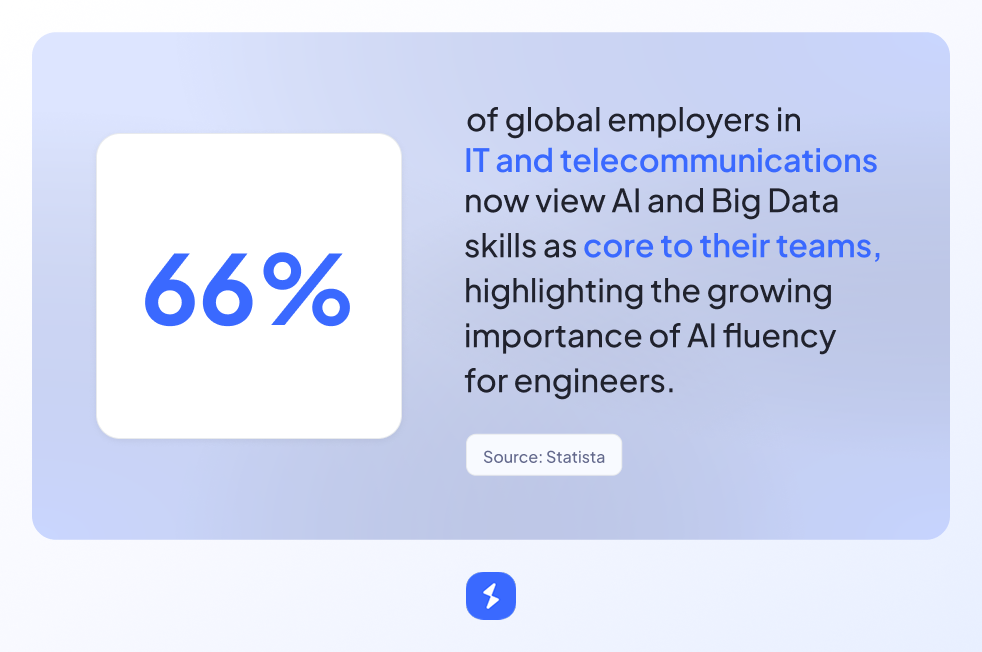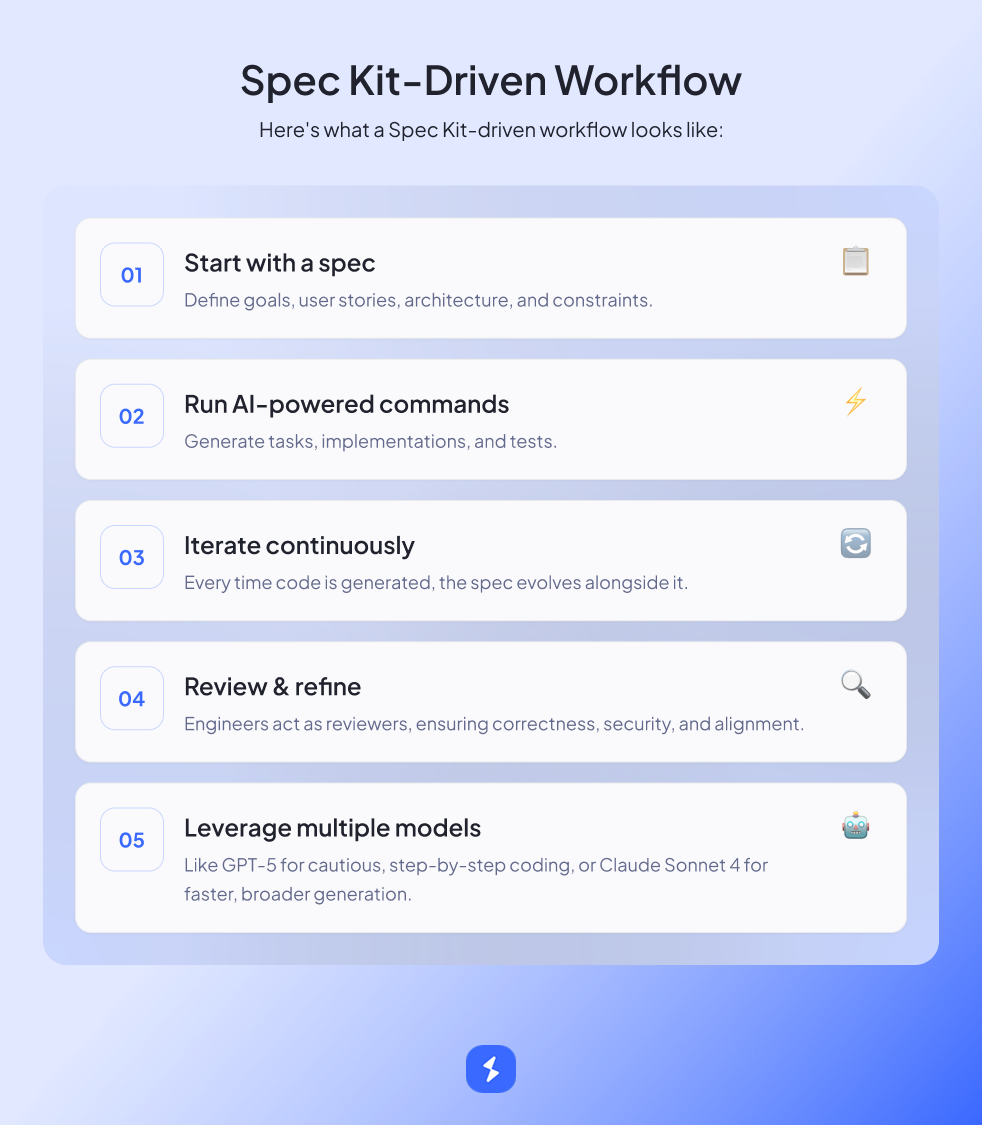I’m Damian Wasserman, co-founder at BEON.tech.
I wrote this as part of my ongoing exploration into how AI is transforming software engineering. Through these posts, I aim to share practical takeaways to help our 150+ BEONers — and the broader developer community — stay at the forefront of this new era of AI-augmented engineering because outcomes matter.
Over the past months, I’ve been diving deep into how AI is reshaping software engineering — not just in what we build, but how we build. In fact, 66% of global employers in IT and telecommunications now view AI and Big Data skills as core to their teams, highlighting the growing importance of AI fluency for engineers.

One concept that stood out recently is Spec-Driven Development, a new approach introduced by GitHub that reframes the role of the engineer in an AI-powered world.
This approach supports the creative process in software development by encouraging structured thinking and iterative refinement from the outset.
One of the clearest overviews I’ve encountered comes directly from the GitHub team, where they demonstrate how the open-source toolkit Spec Kit integrates into the evolving AI developer ecosystem. In this context, providing a high-level description of your project and applying prompt engineering are crucial for guiding AI tools like GitHub Copilot to generate accurate and relevant code.
This is not just another tool—it represents a new engineering paradigm, where:
- Specifications become living documents
- AI handles the heavy lifting
- Developers evolve from coders into orchestrators and reviewers
Spec-Driven Development emphasizes writing specifications and planning ahead before writing code, ensuring clarity and direction from the start. This contrasts with traditional approaches, where coding often begins before fully defining requirements, making specifications a vital step for effective collaboration with AI tools.
In this blog post, I dive into how Spec-Driven Development is changing the way developers work with AI, and why adopting this approach can make a real difference in modern software engineering.
First Things First: What Is Spec-Driven Development?
Let’s start with the basics to understand how we can achieve higher quality code .
In traditional software development, specifications are static documents — often outdated the moment implementation begins.
Spec-Driven Development flips that model:
- The spec becomes a central, living artifact that evolves with the codebase, guided by AI tools that implement, test, and refine features incrementally. The process starts with a detailed specification, including user journeys and a high-level technical implementation plan, ensuring the team is aligned from the outset.
- GitHub’s Spec Kit operationalizes this idea. Using commands like /constitution, /tasks, and /implement, developers define intent and break down tasks, while AI agents create a task list and the coding agent generates code and technical plans. This means agents create actionable steps and the coding agent generates both implementation plans and code artifacts based on the evolving specification.
- During the live session, the team demonstrated bootstrapping a Next.js podcast website entirely through Spec Kit — including AI-generated code, tests, and iterative refinements. The workflow leverages AI tools and AI-assisted coding to build software with less guesswork and fewer surprises, thanks to the iterative nature of the process. The system adapts as specifications evolve, and AI generates outputs that reflect the latest requirements, supporting a collaborative, reliable, and flexible development experience.
Technical Planning for Spec-Driven Development
Technical planning is the backbone of spec-driven development—it sets up the foundation for AI-assisted software engineering that actually works. In this phase, developers go beyond high-level user stories and break them down into the details the coding agent needs to generate solid, reliable code. Think of it as creating a living technical plan that captures implementation steps, tech stacks, and architectural patterns shaping the project.
One of the biggest advantages of spec-driven development is giving the coding agent all the implementation details up front. Developers define:
- Tech stack
- System architecture
- Integration points with legacy systems
- Compliance rules
- Performance targets
With this information, the coding agent can suggest multiple plan variations, letting teams compare approaches and pick the one that fits best with real-world constraints and company standards.
This structured approach also ensures the technical plan includes:
- Internal documentation
- Established architectural patterns
- Necessary compliance requirements
Planning ahead helps teams anticipate challenges, whether it’s legacy systems, existing codebases, or deployment pipelines. The technical plan becomes the north star for the coding agent, guiding new code to meet both functional and non-functional goals.
Context engineering plays a crucial role in this phase. The richer the context you provide—technical details, documentation, system constraints—the better the code the coding agent can generate. Tools like Spec Kit make this process smoother by helping you:
- Capture all required details
- Keep the plan version-controlled and auditable
- Easily update it as the project evolves
In the end, technical planning in spec-driven development isn’t just about writing specs—it’s about reducing guesswork and giving AI a solid foundation. Combine it with context engineering and tools like Spec Kit, and developers get a framework to build software that is aligned, maintainable, and production-ready.
Every line of code ends up grounded in a living, well-defined specification that includes multiple plan variations .
The New Engineering Workflow, More Than Vibe Coding
Here’s what a Spec Kit-driven workflow looks like:
- Start with a spec — define goals, user stories, architecture, and constraints.
- Run AI-powered commands to generate tasks, implementations, and tests.
- Iterate continuously — every time code is generated, the spec evolves alongside it.
- Review & refine — engineers act as reviewers, ensuring correctness, security, and alignment.
- Leverage multiple models — like GPT-5 for cautious, step-by-step coding, or Claude Sonnet 4 for faster, broader generation.

This workflow can be applied to both new projects and an existing codebase, allowing teams to integrate structured, spec-driven development practices regardless of whether they’re starting from scratch or building on current software components.
Unlike prompt driven vibe coding or general vibe coding, which rely on informal, unstructured prompts and often lead to unpredictable or less reliable results, spec-driven development emphasizes clear documentation and structured prompts.
This reduces the unpredictability and inconsistency associated with a prompt driven vibe, ensuring outputs are more:
- Consistent
- Maintainable
- Aligned with project goals.
The result? A development process that’s more aligned, auditable, and iterative, reducing drift between what was intended and what gets built.
Key Learnings from the “Let It Cook” Session
1. Different AI Models, Different Styles
- GPT-5 is more conservative — it pauses for confirmation and works stepwise.
- Claude Sonnet 4 is more aggressive — generating more code and tests upfront.
- Claude Code is another AI-powered coding agent that supports spec-driven development workflows, guiding code generation and structuring project specifications within AI-assisted environments.
Developers can tailor workflows by choosing models strategically, or even combine them using the Model Context Protocol (MCP) to manage context and data across tools.
2. Specifications Evolve With the Code
Specs aren’t one-time artifacts anymore. With Spec Kit, the spec updates automatically as new features are added and tests are run, keeping intent and implementation in sync. This highlights the iterative nature of spec driven development, allowing for continuous updates and refinements as the project evolves. This makes the entire process transparent, maintainable, and self-documenting.
3. Integration with the MCP Registry
The Model Context Protocol (MCP) provides a unified way to connect tools and data sources, now accessible through a public registry and VS Code integration. This allows AI tools to interact with PDFs, spreadsheets, APIs, or databases seamlessly — turning every resource into part of the development context.
4. Sequential Tasks Today, Parallel Agents Tomorrow
Currently, Spec Kit executes tasks sequentially but flags which can be parallelized. True multi-agent parallel execution is on the horizon, opening the door to dramatic productivity gains once coordination challenges are solved.
In the future, coding agents—such as GitHub Copilot, Claude Code, and Gemini CLI—will help manage and coordinate these parallel tasks by generating code, plans, and task breakdowns from high-level prompts.
Features like spec mode will further enhance this process by guiding teams to create structured specifications and detailed task lists before implementation, ensuring more effective collaboration and control in AI-assisted development workflows.
5. The Developer’s Role is Changing
Engineers are shifting from writing every line to guiding AI systems, reviewing outputs, enforcing standards, and evolving specs. Increasingly, the AI agent is becoming a central collaborator in the development process, helping to generate, organize, and execute specifications and tasks.
Success depends less on typing speed and more on system thinking, validation, and iteration.
Why It Matters
Overall, Spec-Driven Development represents a culture shift. It acknowledges that AI can now handle a significant portion of implementation, freeing engineers to focus on architecture, correctness, and design intent.
It also unlocks:
- Faster bootstrapping for new projects, as spec driven development streamlines the process of setting up and initializing a new project with clear, actionable specifications.
- Continuous alignment between spec and code, with the test driven development process helping ensure quality by breaking down tasks into small, testable units.
- Repeatable workflows across teams and organizations, supported by rigorous code reviews and the expertise of software engineers to maintain quality and share context.
- Stronger audit trails for compliance and debugging.
For example, a team might use spec driven development to build authentication by first specifying a user registration endpoint. They would define that this endpoint validates email format, ensuring that only correctly formatted email addresses are accepted. This approach makes input validation explicit and testable.
For teams adopting AI coding assistants, this approach offers a structured framework that balances automation with control, enhancing the effectiveness of AI assisted coding . However, a fundamental challenge remains: obtaining precise human specifications. AI-generated code can sometimes fall short of expectations, especially when requirements are incomplete or vague, and may miss important edge cases. Addressing these issues requires careful attention to detail and ongoing collaboration between humans and AI.
Looking Ahead: Spec-Driven Development in the Future
The Spec Kit team is actively evolving the toolkit — adding CLI improvements, native Windows support, and deeper integration with VS Code and MCP servers. Future versions of Spec Kit will help validate code that AI generates, ensuring outputs meet required standards and security before deployment, and will integrate more seamlessly with your existing codebase.
They’re building a community-first ecosystem, with podcasts, streams, and GitHub collaborations shaping the roadmap.
Spec-Driven Development is still early, but it’s already pointing toward a future where specs, code, and AI collaborate seamlessly, as AI generates code and artifacts with human oversight for accuracy and completeness.
Final Thoughts
We’re entering a world where code becomes the byproduct of clear specifications and powerful AI orchestration.
Spec Kit isn’t about replacing developers — it’s about amplifying them and making their work production ready .
For engineers looking to stay ahead, learning to design, direct, and refine with AI is quickly becoming as important as knowing how to code.
Explore our
AI Hiring Trends 2026: What CTOs Need to Know
The pressure to innovate, control costs, and scale engineering teams is greater than ever. And hiring, in particular, remains one of the biggest challenges. However, AI is moving from hype to becoming a core strategic asset in HR. Some surveys even suggest that by 2026, AI could manage entire recruitment pipelines—making it urgent for leaders…
Remote EOR vs. Contractor: A Strategic Hiring Guide for Tech Leaders
Managing a global workforce has become increasingly complex for tech companies, with many US firms turning to remote teams and international talent pools. The rise of remote work and cross-border hiring means leaders must carefully choose the right employment model. In this guide, we compare the Employer of Record (EOR) model versus directly hiring contractors…
Overemployment: How to Prevent Remote Software Developers from Working Double Jobs
In the era of remote work, companies face a growing challenge: double jobbing. This occurs when a developer secretly holds two full-time positions at once. While remote work has unlocked flexibility and access to global talent, it has also created blind spots. Without in-person oversight, employees can appear to perform adequately while dividing their time…






